The issue with many Celtic symbols is that we can’t offer a definitive guide to what they truly mean. Archaeologists and anthropologists can provide accurate accounts of what symbols mean in other cultures because of written records left behind. However, there are no writings to accompany Celtic symbols, so we are left to provide educated guesses based on what we know about the culture.
It is important to remember that in the Druid faith, placing sacred material in writing was forbidden. The Celts preferred to pass down beliefs and symbolism from generation to generation verbally. However, we try to delve deeper into the meanings of several important Celtic symbols; enjoy!
Celtic Spirals
It appears as if virtually everyone who has a Celtic tattoo opts for the spiral pattern, but how many of these individuals know the real meaning behind it? Spirals are among the oldest decorations created by humans, and they are very apparent in Celtic art and architecture. Experts believe the spiral is the oldest symbol in the Celtic culture and is either representative of the sun or ethereal radiation energy.
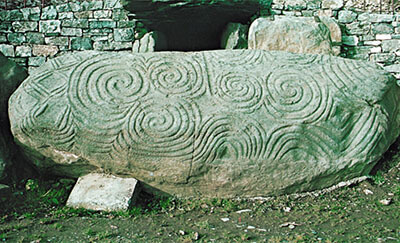
The Celtic Spirals found on the entrance stone to Newgrange, thought to be built around 3200 B.C.
Other scholars suggest that spirals are symbols of the balance between inner and outer consciousness or else they are representative of the journey from materialism & external awareness to the blissful state of enlightenment and cosmic awareness.
Art scholars suggest the direction of Celtic spirals is all-important. If they are clockwise, they are associated with harmony on Earth and the sun. If they are anti-clockwise, they relate to Pagan spells that manipulate nature. According to research by Kate Johnson of Arizona State University in 1991, Celtic spiral patterns were accurate representations of the brightest fixed stars and planetary configurations from thousands of years ago.
The triple spiral was arguably the most important of the Celtic spiral designs regarding significance. This is due to the importance of ‘Triplism’ in the Celtic culture.
Triplism
The number 3 was a significant and powerful number for the Celts and a host of other ancient civilizations. The number was deemed sacred, so anything that appeared in three parts was a representation of great religious value. An array of Celtic divinities appears in threes such as the triple-horned bull in Celtic Britain or the Gallic Mother Goddesses. It is also likely that triplism was merely a way to increase the power of a god.
The number 3 indicates a complete cycle of past, present and future or mother, father and child. It is also possible that the number was represented by three different social functions: The warlike, the sacred and the fertile. In Celtic society, a person’s ‘place’ was determined by the function he/she performed so druids and bards may have enjoyed loftier status than warriors and even kings. Fertility could have been represented by farmers who were responsible for the abundance enjoyed by everyone.
The relevance of the number stretches even further. In Celtic stories, questions are often asked three times. Laws, maxims, knowledge, and poetry rules were always arranged in triads, and the number was associated with luck, importance and magic.
Triskele
The Triskele (also known as the Triskelion) apparently has the same meanings as the Triquetra although it probably carries extra symbolism. Both terms come from the Greek words for ‘three-legged’. Hardly a surprise since the symbol is linked with Spartan warriors who carved a white leg bent at the knee on their shields.
The ancient symbol looks similar to three legs in the process of running. You can also see the Triskele on Syracusan coins from the 4th century BC. A form of the Triskelion symbol was also known in Sicily; in this case, it depicts the Gorgon with her snake hair and three legs bent at the knee stick out from her head.
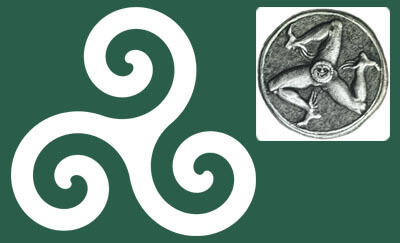
The Celtic Spiral Triskele and the three-legged Triskelion as found on a Syracusan coin.
If you look closely, the Triskele appears as if it is in constant motion. The purpose of the symbol is to outline that we should be in a perpetual state of growth. In ‘Walking a Magic Path,' Rik Potter says it is also an expression of the unity of natural, practical and spiritual magic. The three points are once again representative of the Land, Sea, and Sky.
The three spirals on the Triskele represent the three worlds:
- - The Present World: The physical realm where we live and exist.
- - The Otherworld: The home of spirit guides, our ancestors, and deities.
- - The Celestial World: The sun, moon, stars, and planets.
Archaeologists have found the triple spiral symbol all over the British Isles. Arguably the most famous location is Newgrange, an ancient burial tomb located in Ireland. It was specifically designed to remain dark until the Winter Solstice. At that point, it fills with light and illuminates the spiral designs on the tomb’s walls.
In ‘Symbols in Arts, Religion, and Culture: The Soul of Nature,' Farrin Chwalkowski cites Isaac (2006) and suggests the Triskele is either a Celtic or pre-Celtic symbol that is found in a variety of Irish Megalithic and Neolithic sites such as the aforementioned Newgrange Passage Tomb.
Knots
The seemingly ‘endless’ nature of the Knot is arguably its defining feature. Most versions of Knots are seen in Christian texts such as the Book of Kells. According to Ken Ludden in ‘Mystic Apprentice Volume 3’, interwoven patterns were first seen in the handicrafts of the Roman Empire. Knot patterns came on the scene in the third or fourth century AD, and they were used in Byzantine, Islamic and Celtic art.
Along with spiral, braid, and plait patterns, knots played a major role in Celtic art in around 450 AD just before the culture was heavily influenced by Christianity. Ludden asserts that Celtic knots symbolize the sign of the Cross as it is hidden between the ribbons of the knots. The most basic form of knot is the Triquetra.
Triquetra – Trinity
The term ‘triquetra’ originally meant ‘triangle’ and was used to refer to a variety of three-cornered shapes; a circle was sometimes added inside the symbol or around it. In the Celtic tradition, it was a three-pointed symbol that represented three-way unity. The Celtic version of the symbol features their unique knotwork style which means it is endlessly looping and interweaving. If you see a triquetra symbol with a circle going through it; it means it is a symbol of eternity.
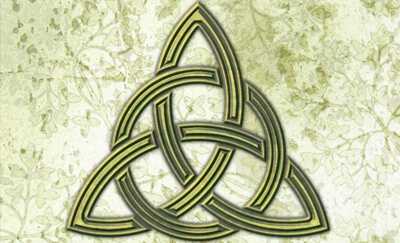
Check out our Trinity Knot Meaning article for more details on this fascinating Celtic symbol.
Evidence of the triquetra dating back 5,000 years has been found. Regarding its use as a Celtic symbol, Rik Potter asserts that it is one of the oldest because it dates back to at least 500 BC. Examples of the symbol were found on early Germanic coins and in Northern Europe.
Perhaps you know this symbol as the Trinity Knot, and it can represent the three promises of a relationship: love, honour and protection. You will often see this design on a Claddagh ring. Christians adopted the symbol and used it to represent the Holy Trinity of the Father, Son, and Holy Spirit.
It is extremely difficult to pin down an exact meaning for the Triquetra as the symbol has several possible meanings. It can represent:
- - The three realms: Earth, Sea & Sky.
- - The three aspects of the goddess: Maiden, Mother & Crone.
- - Body, Mind & Spirit.
- - The interconnected lines symbolise how we are all connected as they are woven together in the web of life.
- - A protective symbol: the interwoven lines ‘confuse’ harmful energy.
There are thousands of variations of knots including Sailor’s, Serpent, Insquare, Eternity (Wedding) and Love Knots. Here you can find a more in-depth study on Celtic Knot meanings.
The Celts & Nature
The Ancient Celts were extremely attuned to nature and revered the phenomena that surrounded them.
Trees Were Sacred
According to Miranda Green in ‘Symbol and Image in Celtic Religious Art,' the Celts used the word ‘nemeton’ to describe the presence of a sacred grove. An example is the sacred oak grove in an area of Asia Minor called Galatia which the Celts called ‘Drunemeton’. Ancient Roman historian Cassius Dio claims there were sacred forests in Southern Gaul used for human sacrifices.
Regarding actual symbols, trees and plants are depicted on Celtic coinage and trees often accompanied other images such as deities. The Celts had a special reverence for oak trees and Druids had an especially close link with oaks. This is hardly a surprise since word ‘druid’ actually comes from the Celtic word for oak.
While trees had a link with fertility, they were inextricably connected with the link between the upper and lower worlds. Trees have their roots deep beneath the earth, and their trunks grow towards the sky. There is a suggestion that the Celts believed the top branches of a tree brushed against heaven. It is likely that on occasion, Celtic warriors would carry the Tree of Life with them into battle for good luck and as a means of reaching the other world.
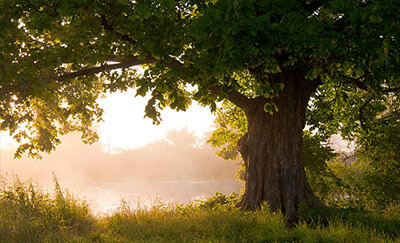
Check out our full range of Tree of Life jewelry, you are sure to find something spellbinding!
Water – The Symbol of Physical and Spiritual Purification
As water was a means of cleansing and a source of life, it was also revered by the Celts. They believed that pure spring water was capable of curing disease. The Celts also noted the cyclical nature of water: It would fall in the form of rain which was a gift from the sky god. Then it was absorbed by the earth which created springs. As a result, water offered an instant link between worlds. Water could heal and give life or destroy and cause death.
Fire
The Scottish and Irish practiced a ritual known as ‘borrowed fire.' In ancient times, keeping the fire alight was of paramount importance, and the hearth was only allowed to die once a year at Beltane Eve. It was relit the next day from another festival fire. If the fire died out at any other time, the Celts had to ‘borrow’ it from a neighbour. No one wanted to do that because they believed the borrower had power over the cattle and wealth of the lender.
The Celtic year was divided into the Dark and the Light. There was a total of four fire festivals to mark the beginning and end of each period:
- - Samhain: Celebrated at the end of summer on October 31.
- - Imbolc: Was a celebration that winter was coming to an end, probably the beginning of February.
- - Beltane: Celebrating summer and the return of life and fertility to the world, end of April or early May.
- - Lughnasadh: Was the beginning of the harvest festival period. Probably celebrated in August.
Animals
Like other ancient civilisations, the Celts viewed the abilities of animals as strange yet desirable. It is likely that bands of warriors aligned themselves with a specific animal (and depicted them on their shields) as a tribute to the aggression, strength and seeming fearlessness of beasts. Let’s take a quick look at some important animals in the Celtic tradition.
Snakes
Celtic symbolism doesn’t represent a snake as an animal; it depicts it as a symbol with various facets. For example, their ability to shed their skin is symbolic of rebirth. The shape of a snake is similar to that of the male organ or the umbilical cord. Since snakes are capable of creating large amounts of offspring, they are also a useful way of representing fertility. The Celts also apparently used the snake as a symbol of secret knowledge.
Horses
The Celts viewed horses as a prized possession and a status symbol. According to Sabine Heinz in ‘Celtic Symbols,' the horse first came to Central Europe in the 8th century BC. As the early Celtic civilisation was looking to expand, the horse was a crucial element of any military campaign. In the early days of Celtic expansion circa 6th century BC, charioteers and riders enjoyed the respect of their people.
The goddess Epona is probably the best-known deity to be associated with horses in the Celtic tradition. As well as being the protector of donkeys, horses, and mules, Epona was the only Celtic goddess worshipped in Rome. Epona is typically depicted standing with horses or fruits (symbols of abundance and fertility). She was worshipped from the 1st to the 4th century AD from Britain to North Africa and her feast day was celebrated on December 18 each year. Other representations of Epona include Rhiannon in Wales.
Bulls
Bulls could mean strength, ferocity, and virility or else these symbols can relate to the importance of oxen in agriculture. There is iconography of bulls found in Europe from long before the Celts arrived. An example is the site of Mont Bego close to the Italian-French frontier. Bulls appear on Celtic coins, and there is a celestial imagery associated with this particular animal. There are coins found in the East which depict bulls with moon signs between their horns. Indeed by themselves, these horns look like a crescent moon.
Ultimately, however, the most obvious symbolism associated with the bull is that of virility (men), fertility (women) and aggression. Apparently, placing the bull symbol in the bed chamber enhanced the mental state and resulted in improved performance. It is also possible that the bull was associated with wealth and abundance. Bear in mind that the bull was an excellent and reliable source of food for the Celts.
What About Other So-Called Celtic Symbols?
There are a vast amount of symbols attributed to the Celts with no basis in fact. The lack of written accounts from the Celtic people poses problems, and it seems as if everyone wants to jump on the bandwagon and incorrectly attribute mystical Celtic meanings to symbols. Evidence suggests the following symbols were probably not associated or meaningful to the Celts. You will see them on a ton of websites but don’t be fooled.
Awen (Three Rays)
Some people claim the Awen is a symbol of male and female energy, and the balance between the two, used by the Celts. In reality, an 18th-century Welsh poet called Iolo Morgannwg probably invented it.
Butterfly
There is a suggestion that the butterfly represented rebirth/regeneration in the Celtic tradition. While this may be true, there is little in the way of evidence to suggest that the butterfly was an important symbol to the Celts. Moreover, there is practically no evidence to show that the Celts believed a butterfly represented a dead person’s soul. Also, the butterfly doesn’t appear in traditional Celtic art.
Celtic Cross
The ‘Celtic’ cross is a Christian symbol although it is rooted in pagan beliefs. Legend has it that St. Patrick combined the Christian Cross with the pagan sun to show newly converted followers of the religion (including Celts) the importance of the cross. He wanted it to symbolise the sun’s life-giving properties; but as the cross is on top of the circle, it signifies Christ’s superiority over the sun.
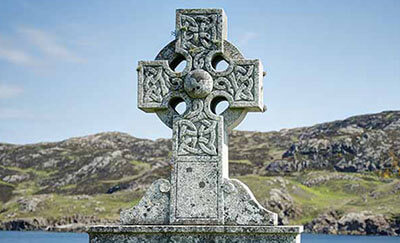
The period of stone cross making ended by the end of the 12th century, then resurged in the 19th century thanks to Celtic revival.
The Celtic High Cross did not make an appearance until the 9th century but the period of stone cross making ended by the end of the 12th century. The usage and creation of Celtic crosses started anew in the mid-19th century thanks to the Celtic revival.
Conclusion
All of the Celtic symbols mentioned in this guide are beautiful, mysterious, and their meanings are often open to interpretation. What we have provided you with is an outline of what leading scholars in the field of Celtic art, architecture, and history believe based on their studies. Let us know what you think these symbols mean. Do you believe they mean something not mentioned in this piece? If so, please let us know!

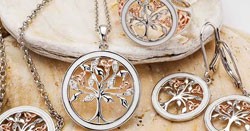
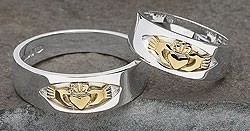
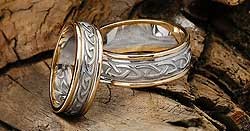
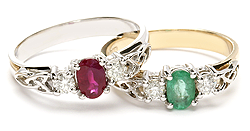
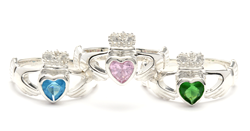
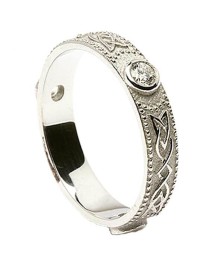 Celtic Diamond Wedding Ring
Celtic Diamond Wedding Ring 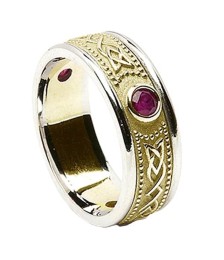 Celtic Diamond Ring with Trim
Celtic Diamond Ring with Trim  Celtic Diamond Ring with Trim
Celtic Diamond Ring with Trim 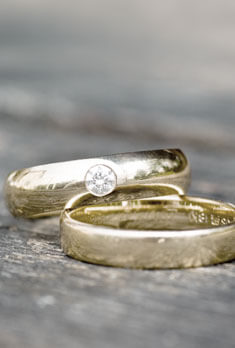

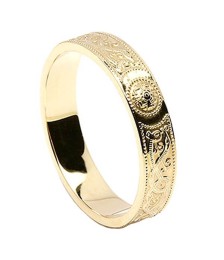 Irish Wedding Ring
Irish Wedding Ring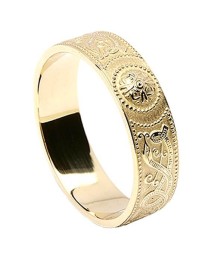 Mens Irish Wedding Ring
Mens Irish Wedding Ring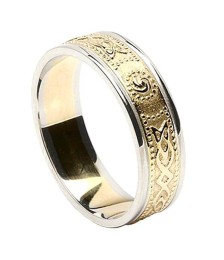 Narrow Irish Ring with Trim
Narrow Irish Ring with Trim